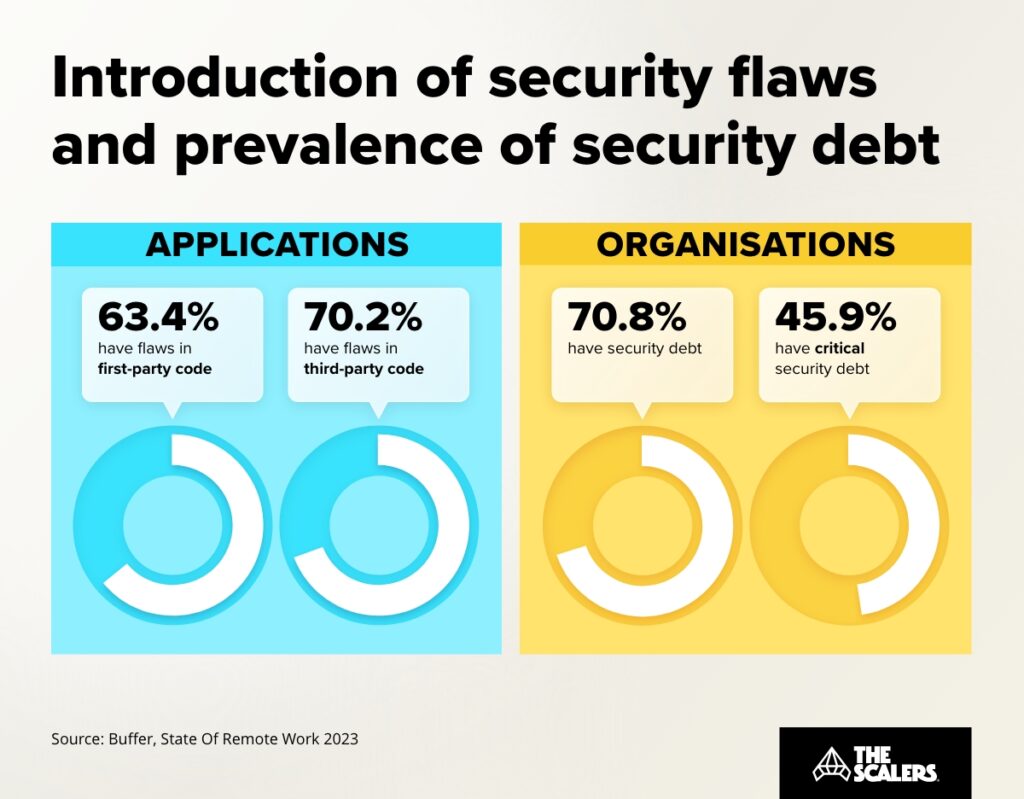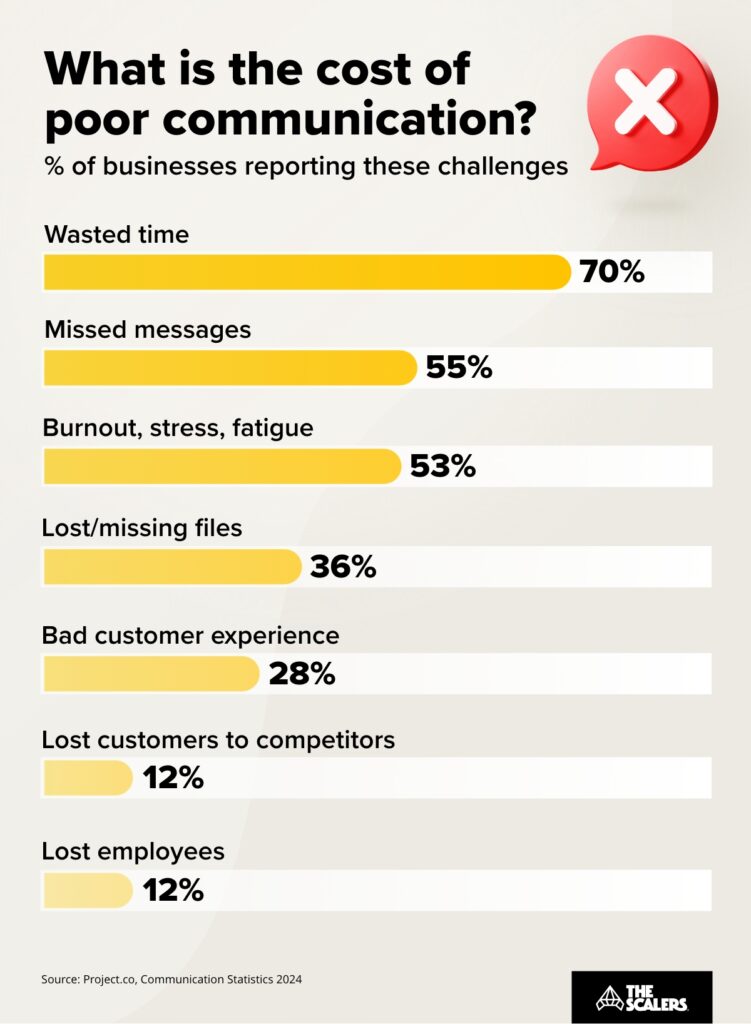Google, Apple, Microsoft, and other tech giants share one thing in common: to become as successful as they are today, they tackled multiple challenges head-on. Their technical teams had to effectively assess and manage risks in software development to create the products we rely on daily.
These obstacles are similar to those of small and medium businesses when developing new applications but, unlike tech giants, they lack the same procedures to avoid costly mistakes. Improper testing or a lack of specialised talent are just some of the pitfalls they face — and one of the reasons why they may consider extending their dev teams offshore.
In this article, we cover the seven most common risks affecting software development projects and how to mitigate them. Plus, we explain why offshoring is an excellent solution to reducing the impact of these risks and even preventing them from arising in the first place.
What are risks in software development?
Software development risks are events or conditions that threaten the success of a software development project. These can be internal (e.g., poor management) or external (e.g., sudden shifts in market demands).
As external risks are often unpredictable, CTOs and other tech leaders typically focus on implementing measures to improve their team’s dynamics in areas they can control.
For example, if their organisation lacks a structured communication strategy for their engineering team to collaborate with key stakeholders, they can implement a plan to ensure alignment inside the company.
So, why do software projects fail?
The failure rate of software projects is a hot topic among industry professionals. According to a recent Boston Consulting Group (BCG) survey, almost half of C-suite executives reported that over 30% of their organisation’s tech development projects exceeded budgets and missed deadlines.
But why do these projects frequently fall short of expectations? Are there common signs that explain the growing frustration among tech teams failing to meet business goals?
BCG’s survey identified the top three reasons why IT projects fail. These are:
- Lack of alignment between the technology and business sides of the organisation about operational objectives.
- Insufficient resources.
- Unrealistic timelines.
Several of these reasons for failure align with the most common software development risks businesses tend to encounter.
The 7 most common risks in software development projects
Drawing from our experience building over 80 tech teams in the past 10+ years — and conversations with tech leaders looking to build dedicated development teams — here’s a list of the most common software development risks organisations face.
1. Unqualified tech talent
Lacking the right talent to build software presents a high risk to a tech team’s core functioning or a project’s success. The results can be disastrous:
- Poor code quality.
- Inefficient system architecture.
- Unexpected post-release bugs.
And the list goes on.
Building a team of low-quality developers who lack niche skills is arguably the most critical risk an organisation can face. Subpar developers are at the root of every other risk — data breaches, insufficient testing, or organisational issues.
These professionals don’t always follow development best practices, skipping important steps and compromising the quality of the final product. In most cases, this low quality stems from the limited availability of specialised tech talent in local markets.

How to mitigate it?
One of the best ways to mitigate this risk is to find and hire dedicated developers from a reliable partner.
Only these providers can guarantee to build a dedicated development team formed by world-class professionals possessing in-demand programming skills and soft skills such as creative thinking and a proactive attitude.
2. Inconsistent project deadlines
Tech teams usually feel pressured to complete projects earlier than expected, even when the agreed deadline is set to a later date. This rush to deliver results as soon as possible can lead to prioritising quick fixes over optimal solutions.
The mid/long-term consequences of such practices? The accumulation of technical debt and the inability to address it properly — not to mention developer burnout caused by tight schedules and unrealistic expectations.
Organisations that work with inconsistent project deadlines risk delaying product releases or, worse, releasing incomplete or buggy software.
How to mitigate it?
There are several project management strategies that can help tech leaders mitigate working with unclear deadlines. For those working in Agile, timeboxing is a technique worth exploring.
A timebox is a time limit set to complete a task. Scrum meetings or sprints are a good example of Agile timeboxes.
Fast-tracking is another strategy that can be implemented by dev teams working with tight deadlines. For instance, two teams can work on requirement analysis and development simultaneously. As long as both teams practice good communication, this technique can help deliver projects at a faster pace.
3. Security vulnerabilities
Cyber threats can affect the software development cycle at every stage, from design to testing to maintenance, and they often carry significant financial consequences for organisations.
According to a recent IBM report, the global average cost of a data breach in 2024 has reached $4.88 million, marking a 10% increase from 2023 and the highest total ever recorded.
When tech teams don’t comply with secure coding practices, they not only expose their companies to financial losses but also compromise their industry reputation and risk letting customer data fall into the wrong hands.

How to mitigate it?
Besides implementing secure coding practices, tech leaders should train their teams in the latest cybersecurity techniques and use methods like multi-factor authentication and data encryption. Partnering with secure third companies, such as those with ISO certification, can further strengthen their defences.
4. Budget changes
Completing a software development project only to realise that the final cost is way lower or higher than agreed is a nightmare for any business.
This can happen for several reasons:
- A poor budget allocation strategy.
- No project expense tracking.
- Scope creep.
Scope creep is often the biggest culprit and a common cause of budget changes. It occurs when a project starts with clear, well-defined requirements, but as it progresses, new requirements are added or removed.
By the time the project reaches completion, what was once well-organised turns into a chaotic, undefined project that strays far from the original plan in both shape and cost.
How to mitigate it?
Business leaders should aim to set project parameters beforehand. If new features or requirements are added, they must make the necessary adjustments, estimate additional costs, and keep stakeholders informed.
5. High developer turnover rate
A tech team with a high developer turnover rate is less likely to complete a successful project than a team with professionals who have long tenure and experience working together.
Why? If a developer leaves a company at a crucial stage of the development cycle, its team loses a specialist with deep knowledge of the project, creating gaps that can delay progress or lead to setbacks.
Today, most tech employees are thinking about changing roles. A Gartner survey revealed that only 29% of IT workers are highly committed to staying with their current employer. The main causes for them considering switching jobs include the following:
- Poor management.
- Lack of recognition.
- Insufficient compensation.
- Toxic working atmosphere.
- No career growth opportunities.
Food for thought for business leaders…
How to mitigate it?
One of the best solutions to tackling high turnover rates is to invest in building a strong dev team culture. Establishing a shared vision, goals, and purpose is generally too expensive for most local teams but possible with the right offshore partner.
Organisations that collaborate with a trusted offshore development company can set up a team that works just for them, with no rotations, 100% committed and culturally aligned with their values.
Some offshore companies go beyond sourcing, hiring, and onboarding engineers. They also engage with them and guarantee their daily satisfaction.
6. Unclear communication
A software development project with poor communication between tech teams and stakeholders is doomed for failure. If developers are unclear about the exact requirements, the project’s final goal, or the next steps, the result will likely differ from expectations.
Let’s say a dev team develops an e-commerce platform per stakeholders’ request. The only condition stakeholders have is that it needs to have an “intuitive checkout process” without specifying more details.
So, the developers decide to implement a single-page checkout, while the stakeholders envisioned a multi-step process with added payment options. The miscommunication between both parties led to wasted time and frustration for everyone involved in the process.
These situations are quite common when organisations outsource software development, as one of the most common problems with outsourcing is the loss of control companies have over projects.
After all, outsourced engineers are external contractors who may not use the same tools or comply with the same processes or standards as organisations’ in-house teams.

How to mitigate it?
Business leaders need to establish a culture of honesty and encourage their dev team to express hesitations, complaints, and other concerns.
Setting up weekly meetings with developers and stakeholders to ensure everyone is on the right track is a good way for managers to assess the project’s progress and address any roadblocks. This ensures that everyone is aware of the project’s status and requirements at all times.
7. Improper testing
Performing no testing or minimal testing is one of the most common risks in software development, as many organisations overlook this step.
Tech teams must implement a comprehensive testing process to detect bugs and other issues early on if they want their product to be released without major flaws. Insufficient testing can generate problems, including:
- Security weaknesses.
- Poor user experience.
- Customer dissatisfaction.
- Bad software performance.
- High maintenance and support costs.
And, most importantly, it can harm the reputation of businesses and dev teams for releasing unfinished or buggy products.
How to mitigate it?
The obvious answer would be to establish a testing process and train developers in testing best practices. However, 48% of organisations face challenges in reaching software quality goals because they lack time and skilled resources.
Companies can consider hiring a QA team through offshoring to solve this issue. This way, they can hire high-quality QA Managers, Test Automation Engineers, or any other specialist they need to build a strong QA and testing culture in their business.
Reduce risks in software development with offshoring
Thus far, we’ve talked about several ways of mitigating software development risks, including building teams or hiring niche talent via offshoring.
However, most offshore service providers rely on a one-size-fits-all approach, grouping all partners together as if their needs were the same.
At The Scalers, we defy the norm. We’ve crafted a unique and proven model that not only offers companies a customised approach to their requirements but also delivers other advantages, such as:
- Building integrated and culturally aligned teams.
- Getting enhanced security and data protection.
- Having the flexibility to scale at speed.
- Enjoying hands-off operations.
The Scalers’ offshore model has assisted organisations of all sizes and industries in the past 10+ years to set up resilient, high-performing teams with the top 1% of tech talent in India.
Take Preqin, a UK FinTech, as an example: we helped them build a 450+ person R&D centre in Bangalore, pivotal to launching their flagship product Preqin Pro.
Working with The Scalers has enabled us to scale a really high-performing quality, quality team. They’ve been able to take a lot of the load off us, taking on the business function, the HR function, the recruitment function, to enable us to really spend our time building quality software and collecting quality data. We felt that our values were aligned and what we’ve built over the last five years is just phenomenal and we wouldn’t have been able to do it without The Scalers’ support.

If you’re interested in knowing how we can assist you in setting up an elite offshore team in Bangalore, ‘The Silicon Valley of Asia’, fill out this form telling us your unique requirements. One of our senior executives will promptly get back to you with an answer!
If you’re still deciding whether offshoring is a good fit for your organisation, we invite you to read our offshore software development guide. It compiles everything you need to know about this hiring and engagement model.
In summary
While the seven risks in software development analysed in this article are the most common, tech leaders should be aware of other challenges they may face when starting a new task or project.
These obstacles can vary depending on the business type, industry, and project scope. However, one thing is certain: following the recommendations in this guide serves as a comprehensive manual for any manager aiming to minimise significant risks.
-
1
Hiring unqualified tech talent is the root of many software development risks.
-
2
Unrealistic deadlines lead to technical debt and developer burnout.
-
3
Security vulnerabilities can result in significant financial losses and damaged reputations.
-
4
Poor budget management often stems from scope creep and unclear requirements.
-
5
High developer turnover disrupts project continuity and team dynamics.
-
6
Clear communication between teams and stakeholders prevents costly missteps.
-
7
Insufficient testing compromises software quality and user satisfaction.
-
8
Offshore software development provides access to niche talent and reduces common development risks, among other benefits.
Do you want to know more about offshore software development? Below, you’ll find a short list of related articles that can help you leverage offshoring and start building your new team.
For instance, we’ve written an article on strategies to drive innovation into software development you might find interesting!
Build Your Team,
Not Just a Contract
With The Scalers’ offshore dedicated development team, you get engineers who join your workflow for the long run. Grow steadily, stay flexible, and work with people who care about the product as much as you do.








